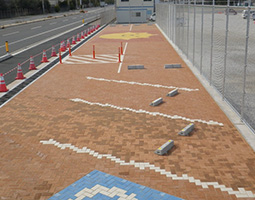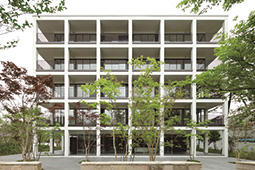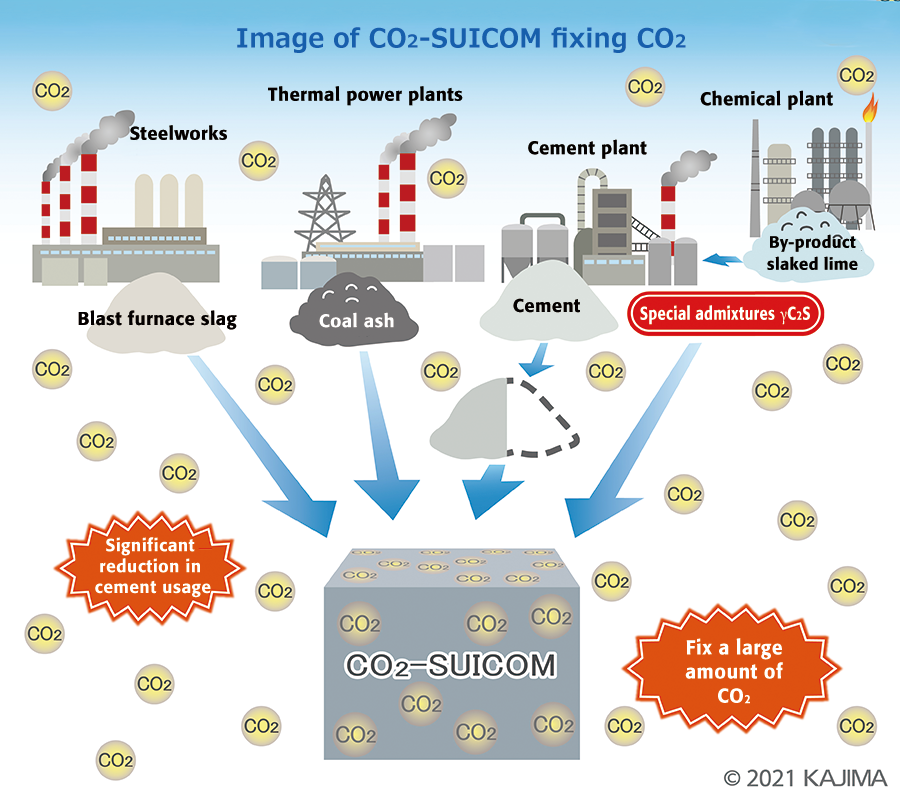
Comparison of CO2 emissions during manufacturing of conventional concrete and CO2-SUICOM (estimate)
CO2-SUICOM: Reduces 197 kilograms of CO2 per cubic meter by substituting some of the cement that emits a large amount of CO2 during manufacturing with special admixtures that emit less CO2 and industrial by-products such as blast furnace slag fine powder. In addition, carbonation absorbs 109 kilograms of CO2 per cubic meter.
Road pavement blocks made using CO2-SUICOM 
Road boundary blocks made using CO2-SUICOM 
Brillia ist NAKANO CENTRAL PARK in Nakano City, Tokyo. The apartment block uses CO2-SUICOM for its balconies, as part of urban development with environmental consideration as one of its projects. CO2-SUICOM also has the effect of protecting reinforced concrete in places exposed to the outside air.
October 2021
Concrete that Absorbs Carbon Dioxide

A new type of concrete has been developed that uses materials which absorb carbon dioxide (CO2) to reduce CO2 emissions during manufacturing to virtually zero.

CO2-SUICOM: Reduces 197 kilograms of CO2 per cubic meter by substituting some of the cement that emits a large amount of CO2 during manufacturing with special admixtures that emit less CO2 and industrial by-products such as blast furnace slag fine powder. In addition, carbonation absorbs 109 kilograms of CO2 per cubic meter.
Since CO2 reduction has turned into an international issue as a measure to prevent global warming, the Japanese construction industry is developing various technologies to reduce CO2 emissions. The reduction of CO2 emissions associated with concrete production is one among them. Concrete is usually made from materials such as cement,i water, sand and gravel. Cement plays an important role as it reacts with water to solidify the concrete, but it also emits a lot of CO2 during manufacturing. Therefore, the industry is making efforts to reduce CO2 emissions by replacing cement with industrial byproducts (blast furnace slag, coal ash, or the like) produced at steel mills and thermal power plants. Concrete is said to be the second most consumed substance in the world after water, and its impact on the environment is highly significant.
In 2011, Kajima Corporation, the Chugoku Electric Power Company, Incorporated, Denka Company Limited, and Landes Co., Ltd. jointly developed CO2-SUICOM, the world’s first type of concrete that reduces CO2 emissions during manufacturing to virtually zero or less. CO2-SUICOM is an acronym for “CO2-Storage Utilization for Infrastructure by Concrete Materials.” Compared to ordinary concrete, which emits 288 kg of CO2 per cubic meter during production, CO2-SUICOM cuts 306 kg of CO2 per cubic meter by both absorbing and reducing CO2. In other words, CO2 emissions from concrete production will be virtually zero or less, and the more CO2-SUICOM is made, the more CO2 will be reduced (see figure).
Torichigai Takeshi, Chief Research Engineer in the Concrete and Construction Materials Group at Kajima Technical Research Institute, comments, “CO2-SUICOM is made by combining the new technology of concrete carbonation with the conventional technology that uses industrial byproducts.”
Carbonation absorbs and fixes CO2 in concrete by causing the cement to react with CO2. According to Torichigai, this technology emerged out of research on extending the life of concrete. The inspiration came from a survey of the remains of a concrete dwelling built about 5,000 years ago and discovered at the Dadiwan site in China. Modern concrete has a lifespan of about 100 years, but the concrete found at Dadiwan had more or less retained its original form.


Torichigai explains, “A survey conducted by the research team found that the people of the time built the concrete structure on the ground. They then used clay to construct dome-shaped walls on top of the concrete and lit a fire inside the structure to dry it. In short, when the concrete was solidified inside that sealed space with a high concentration of CO2, it absorbed, by coincidence, a large amount of the CO2. Thanks to the carbonation, the concrete was formed in a chemically stable state and retained its original shape for 5,000 years.”
Based on this survey, Kajima chose γ (gamma) C2S as the material for CO2-SUICOM. Made from calcium hydroxide and silica, γ-C2S is a powdery substance with a property that reacts with CO2 and hardens. In other words, γ-C2S is a material with a CO2 absorbent function in addition to the same function as cement to harden concrete.
In 2006, Kajima developed a commercial version of long-life concrete by using γ-C2S to absorb CO2. As a result of further research, Kajima perfected CO2-SUICOM, a completely new type of concrete, which uses γ-C2S and industrial byproducts from thermal power plants and steelworks as the main materials to absorb and harden large amounts of CO2. Compared to conventional concrete, CO2-SUICOM reduces the amount of cement by half. In addition, since CO2-SUICOM fixes CO2 when it hardens, it contributes to reducing CO2. As a proof-of-concept, the company has also successfully fixed exhaust gas (CO2) from a thermal power plant, showing that it is possible to directly capture and reduce the CO2 in exhaust gases.

CO2-SUICOM is currently used in boundary blocks between sidewalks and roadways, road pavement blocks, river embankment blocks, and in balcony ceilings for apartment buildings. There is much interest from overseas, especially from Western companies with a strong awareness of measures to prevent global warming. Several companies have expressed interest in commercializing and selling our products.
CO2-SUICOM is also attracting attention because it was mentioned as an example of a practical application of carbon recycling in the “Green Growth Strategy Through Achieving Carbon Neutrality in 2050” published by the Japanese government (Ministry of Economy, Trade and Industry) in December 2020.
Torichigai comments, “If CO2-SUICOM is used in large-scale buildings and public facilities, costs will go down and the effect of CO2 reduction will be enhanced. We would like to contribute to carbon recycling worldwide by escalating its use.”
* Cement is a powder used as a binding material in the production of concrete. The most commonly used powder is Portland cement made by adding gypsum to clinker, which has been heated in a kiln after mixing with limestone, clay, or other materials.


